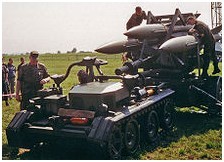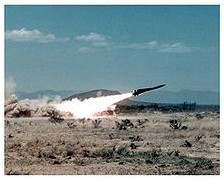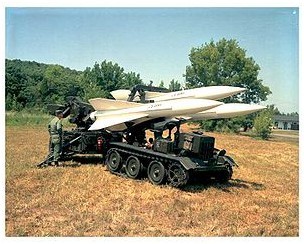
MIM-23 Hawk
USINFO | 2013-11-21 14:39

A Hawk system in service with theGerman Luftwaffe before it was phased out
The Raytheon MIM-23 Hawk(Homing All the Way Killer) is a U.S. medium range surface-to-air missile. The Hawk was initially designed to destroy aircraft and was later adapted to destroy other missiles in flight. The missile entered service in 1960, and a program of extensive upgrades has kept it from becoming obsolete. It was superseded by the MIM-104 Patriot in United States Army service by 1994. It was finally phased out of U.S. service in 2002, the last U.S. users, the U.S. Marine Corps replacing it with the man-portable infrared-guided visual range FIM-92 Stinger. The missile was also produced outside the US in Western Europe, Japan and Iran.Although the U.S. never used the Hawk in combat, it has been employed numerous times by other nations. Approximately 40,000 of the missiles were produced. Jane's reported that the original system's single shot kill probability was 0.56; I-Hawk improved this to 0.85.
Development
Development of the Hawk missile system began in 1952, when the United States Army began studies into a medium range semi-active radar homingsurface-to-air missile. In July 1954 development contracts where awarded to Northrop for the launcher, radars and fire control systems, whileRaytheon was awarded the contract for the missile. The first test launch of the missile then designated the XSAM-A-18 happened in June 1956. By July 1957 development was completed, by which time the designation had changed to XM3 and XM3E1. Very early missiles used the Aerojet M22E7 which was not reliable; the problems were resolved with the adoption of the M22E8 engine.The missile was initially deployed by the U.S. Army in 1959, and by the US Marine Corps in 1960.
The high complexity of the system, and the quality of tube-based electronics, gave the radars in the early Hawk systems a MTBF of only 43 hours. The improved Hawk system increased this to 130 to 170 hours. Later Hawk versions improved this further to between 300 and 400 hours.
Improved Hawk or I-Hawk The original Hawk system had problems engaging targets at low altitude - the missile would have problems picking the target out against ground clutter. The U.S. Army began a program to address these issues in 1964 - the Hawk Improvement Program (Hawk/HIP). This involved numerous upgrades to the Hawk system:
- A digital data processing central information coordinator for target processing, threat ordering, and intercept evaluation.
- An improved missile (MIM-23B) with a larger warhead, smaller and more powerful M112 motor, and improved guidance section.
- The PAR, CWAR, HPI, and ROR were replaced by upgraded variants (see #Radars).
Product Improvement Plan In 1973 the U.S. Army started an extensive multi-phase Hawk PIP (Product Improvement Plan), mainly intended to improve and upgrade the numerous items of ground equipment.
- Phase I
- : Phase I involved replacement of the CWAR with the AN/MPQ-55 Improved CWAR (ICWAR), and the upgrade of the AN/MPQ-50 PAR to Improved PAR (IPAR) configuration by the addition of a digital MTI (Moving Target Indicator). The first PIP Phase I systems were fielded between 1979 and 1981.
- Phase II
- : Developed from 1978 and fielded between 1983 and 1986. upgraded the AN/MPQ-46 HPI to AN/MPQ-57 standard by replacing some of the vacuum tube based electronics with modern solid-state circuits, and added an optical TAS (Tracking Adjunct System). The TAS, designated OD-179/TVY, is an electro-optical (TV) tracking system that increases Hawk operability and survivability in a high-ECM environment.
- Phase III
- : The PIP Phase III development was started in 1983, and was first fielded by U. S. forces in 1989. Phase III was a major upgrade which significantly enhanced the computer hardware and software for most components of the system, a new CWAR the AN/MPQ-62, added single-scan target detection capability, and upgraded the HPI to AN/MPQ-61 standard by addition of a Low-Altitude Simultaneous Hawk Engagement (LASHE) system. LASHE allows the Hawk system to counter saturation attacks by simultaneously intercepting multiple low-level targets. The ROR was phased out in Phase III Hawk units.
Hawk Missile Restore Reliability (MRR)
This was a program that ran between 1982 and 1984 intended to improve missile reliability.
Hawk ECCM
Running alongside the MMR program, this produced ECCM to specific threats, probably contemporary Soviet ECM pods such as the SPS-141 fitted to the Su-22, which proved moderately effective during the Iran-Iraq War. The MIM-23C and E missiles contain these fixes.
Low clutter enhancements
Upgrades to the missile that takes it up to MIM-23G that enable the missile to deal with low flying targets in a high clutter environment. These were first deployed in 1990.
Hawk missile ILM (Improved lethality modification)
To improve the lethality of the warhead of the missile against ballistic missiles, the warhead was redesigned to produce fewer larger fragments, typically 35 grams each comparable to a 12.7 mm projectile in mass.
Hawk mobility and TMD upgrades
A Hawk mobility survivability enhancement programme has been developed following experience in the 1990 Gulf War. The aim of this programme was to reduce the number of support vehicles per battery and to increase survivability. Upgrades to the launcher allow missiles to be transported on the launcher itself, as well as replacing vacuum tubes with a single laptop computer. A north finding system speeds orientation and launcher alignment. A field wire replaces heavy cables and allows for greater dispersion amongst battery vehicles from 110 m to 2 km. The upgrades where deployed by the US Marine Corps between early 1995 and September 1996.
Phase IV
With both the Army and USMC abandoning the Hawk, phase IV was never completed. However it was planned to include:
- High mobility continuous wave acquisition radar to improve detection of small UAVs.
- A new CW engagement radar.
- Anti-radiation missile decoys.
- An improved missile motor.
- An upgraded electro-optical tracker.
- Improved command and control.
- ATBM upgrades.
Hawk XXI (Hawk 21)
The Hawk XXI or Hawk-21 is a more advanced, and more compact version of Hawk PIP-3 upgrade. Hawk-XXI basically eliminates the PAR and CWAR radars with the introduction of 3D MPQ-64 Sentinelradars. Norway's Kongsberg Company provides an FDC (Fire Distribution Center) as it is used in NASAMS system in Norway. The missiles are upgraded MIM-23K standard with an improved blast-fragmentation warhead that creates a larger lethal zone. The system is also effective against short range tactical ballistic missiles.
A MPQ-61 HIPIR radar provides low altitude and local area radar coverage as well as continuous wave radar illumination for the MIM-23K Hawk missilles.
Description

Launch of a Hawk missile
The Hawk system consists of a large number of component elements. These elements were typically fitted on wheeled trailers making the system semi-mobile. During the system's 40-year life span, these components were continually upgraded.The Hawk missile is transported and launched from the M192 towed triple-missile launcher. A self-propelled Hawk launcher, the SP-Hawk, was fielded in 1969, which simply mounted the launcher on a tracked M727 (modified M548), however the project was dropped and all activity terminated in August 1971.
The missile is propelled by a dual thrust motor, with a boost phase and a sustain phase. The MIM-23A missiles were fitted with an M22E8 motor which burns for 25 to 32 seconds. The MIM-23B and later missiles are fitted with an M112 motor with a 5 second boost phase and a sustain phase of around 21 seconds. The M112 motor has greater thrust, thus increasing the engagement envelope.
The original MIM-23A missiles used a parabolic reflector, but the antenna directional focus was insufficient, when engaging low flying targets the missile would dive on them, only to lose them in the ground clutter. The MIM-23B I-Hawk missiles and later uses a low side lobe, high-gain plane antenna to reduce sensitivity to ground clutter in addition to an inverted receiver developed in the late 1960s to give the missile enhanced ECCM ability and to increase the Doppler frequency resolution.
A typical Basic Hawk battery consists of:
- 1 × PAR: Pulse Acquisition Radar—a search radar with a 20 rpm rotation, for high/medium altitude target detection.
- 1 × CWAR: Continuous Wave Acquisition Radar—a search doppler radar with a 20 rpm rotation, for low altitude target detection.
- 2 × HPIR: High Power Illuminator doppler Radar—target tracking, illumination and missile guidance.
- 1 × ROR: Range Only Radar—K-band pulse radar which provides range information when the other systems are jammed or unavailable.
- 1 × ICC: Information Coordination Central
- 1 × BCC: Battery Control Central
- 1 × AFCC: Assault Fire Command Console—miniature battery control central for remote control of one firing section of the battery. The AFCC controls one CWAR, one HPI, and three launchers with a total of nine missiles.
- 1 × PCP: Platoon Command Post
- 2 × LCS: Launcher Section Controls
- 6 × M-192: Launchers with 18 missiles.
- 6 × SEA: Generators 56 kVA (400 Hz) each.
- 12 × M-390: Missile transport pallets with 36 missiles
- 3 × M-501: Missile loading tractors.
- 1 × [bucket loader]
- 1 × Missile test shop AN/MSM-43.
A typical Phase-III Hawk battery consists of:
- 1 × PAR: Pulse Acquisition Radar—a search radar with a 20 (+/-2) rpm rotation, for high/medium altitude target detection.
- 1 × CWAR: Continuous Wave Acquisition Radar—a search doppler radar with a 20 (+/-2) rpm rotation, for low altitude target detection.
- 2 × HIPIR: HIgh Power Illuminator doppler Radar—target tracking, illumination and missile guidance.
- 1 × FDC: Fire Distributuon Center
- 1 × IFF: Identification Friend or Foe Transceiver
- 6 × DLN: Digital Launchers with 18 missiles.
- 6 × MEP-816: Generators 60KW (400 Hz) each.
- 12 × M-390: Missile transport pallets with 36 missiles
- 3 × M-501: Missile loading tractors.
- 1 × [bucket loader]
Missiles
The Hawk missile has a slender cylindrical body and four long chord clipped delta-wings, extending from mid-body to the slightly tapered boat-tail. Each wing has a trailing-edge control surface.
- The MIM-23A is 5.08 metres (16.7 ft) long, has a body diameter of 0.37 metres (1 ft 3 in), a wing span of 1.21 metres (4 ft 0 in) and weighs 584 kilograms (1,287 lb) at launch with a 54 kilograms (119 lb) HE blast/fragmentation warhead. It has a minimum engagement range of 2 kilometres (1.2 mi), a maximum range of 25 kilometres (16 mi), a minimum engagement altitude of 60 metres (200 ft) and a maximum engagement altitude of 11,000 metres (36,000 ft).
- The MIM-23B to M versions are 5.03 m (16.5 ft) long, have a body diameter of 0.37 m (1 ft 3 in) and, with a larger warhead of 75 kg (165 lb), weighing 638 kg (1,407 lb) at launch. An improved motor, with a total weight of 395 kg (871 lb) including 295 kg (650 lb) of propellant, increases the maximum range of the MIM-23B to M versions to 35 km (22 mi) and maximum engagement altitude to 18,000 m (59,000 ft). The minimum range is reduced to 1.5 km (0.93 mi). The MIM-23B has a peak velocity of around 500 m/s (1,600 ft/s). The missile is fitted with both radio frequency proximity and impact fuses. The guidance system uses an X-band CW monopulse semi-active radar seeker. The missile can maneuver at 15 g.
Basic Hawk: MIM-23A
The original missile used with the system. The 54-kilogram (119 lb) warhead produces approximately 4,000 8-gram (0.28 oz) fragments that move at approximately 2,000 meters per second (6,600 ft/s) in an 18 degree arc.
I-Hawk: MIM-23B
The MIM-23B has a larger 74 kg (163 lb) blast-fragmentation warhead, a smaller and improved guidance package, and a new M112 rocket motor. The new warhead produces approximately 14,000 2-gram (0.071 oz) fragments that cover a much larger 70 degree arc. The missiles M112 rocket motor has a boost phase of 5 seconds and a sustain phase of 21 seconds. The motors total weight is 395 kg (871 lb) including 295 kg (650 lb) of propellant. This new motor improves the engagement envelope to 1.5 to 40 km (0.93 to 25 mi) in range at high altitude, and 2.5 to 20 km (1.6 to 12 mi) at low altitude, the minimum engagement altitude is 60 meters (200 ft). The missile was operational in 1971. All US units had converted to this standard by 1978.
- MTM-23B training missile.
- XMEM-23B Full telemetry version for testing and evaluation purposes.
System components
The Hawk and Improved Hawk structure was integrated into one system - AN/TSQ-73 air defense missile control and coordination system, called Missile Minder or Hawk-MM. It consists of the following components: MPQ-50 Pulse Acquisition Radar, MPQ-48 Improved Continuous Wave Acquisition Radar, TSW-8 Battery Control Central, ICC Information Coordination Central, MSW-11 Platoon Command Post, MPQ-46 High Power Illuminator, MPQ-51 Range Only Radar and the M192 Launcher.
Improved ECCM
| 1959 Basic HAWK | MIM-23A | ||||||||||||||||||||||||||||||
| 1971 I Hawk | MIM-23B | ||||||||||||||||||||||||||||||
| 1982 Improved ECCM | MIM-23C | ||||||||||||||||||||||||||||||
| MIM-23D | |||||||||||||||||||||||||||||||
|
1990 Improved guidance section and ECCM |
MIM-23E | MIM-23F | |||||||||||||||||||||||||||||
| Improved body section | MIM-23G | MIM-23H | |||||||||||||||||||||||||||||
| Anti-TBM configuration | MIM-23K | MIM-23J | |||||||||||||||||||||||||||||
| Enhanced fuse | MIM-23L | MIM-23M | |||||||||||||||||||||||||||||
- MIM-23C
- MIM-23D
Low level/multi jamming
- MIM-23E/F
New body section
- MIM-23G/H
New warhead + fuzing (anti-TBM)
- MIM-23K/J
New fuzing + old warhead
- MIM-23L/M
Radars
The original Hawk system used 4 radars: to detect (PAR and CWAR), to track (CWAR and HPIR) and to engage (HPIR and ROR) targets. As the system was upgraded the functionality of some of the radars was merged. The final iteration of the system consists of only 2 radars, an enhanced phased array search radar and an engagement radar (HPIR).
Share this page




















